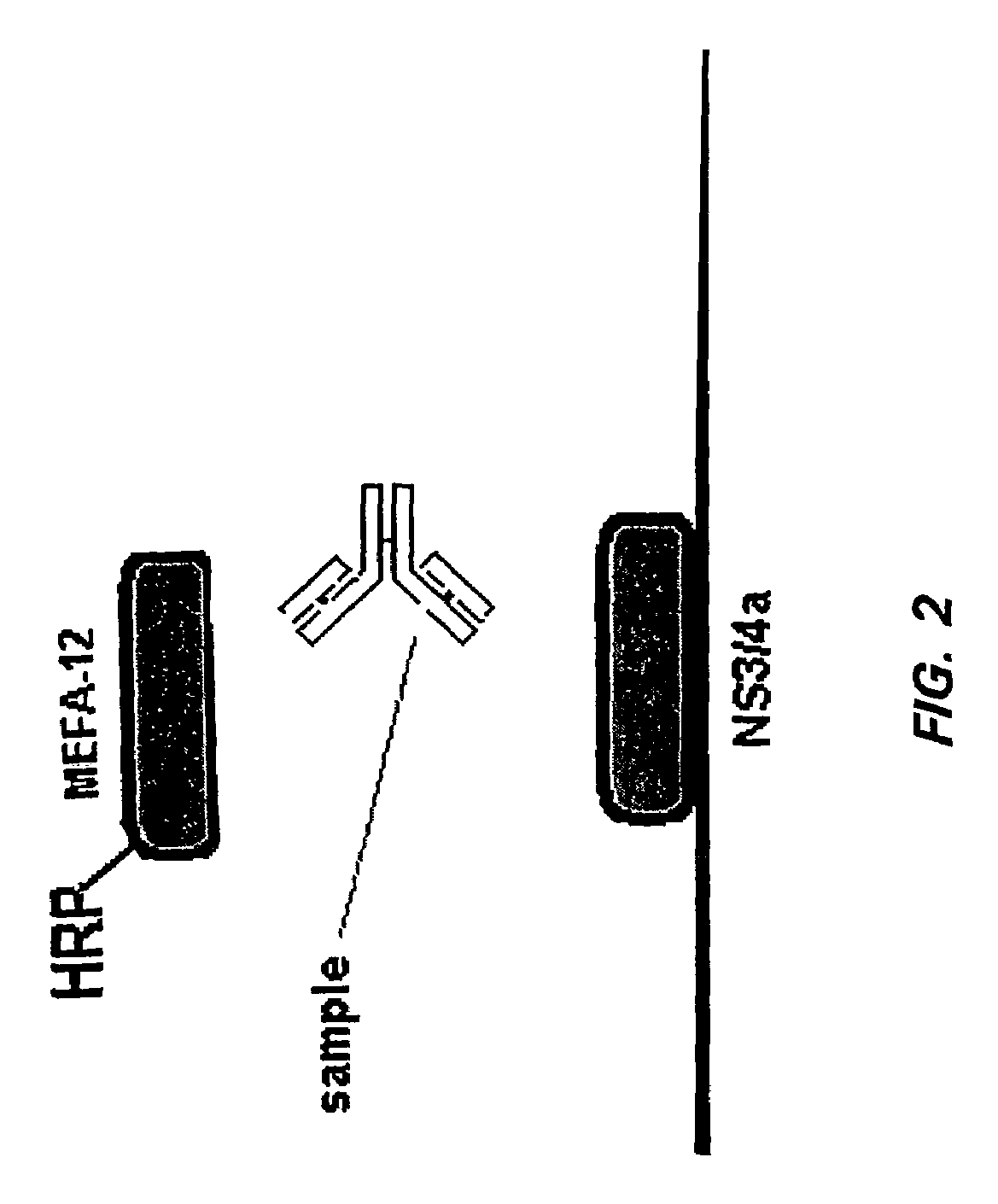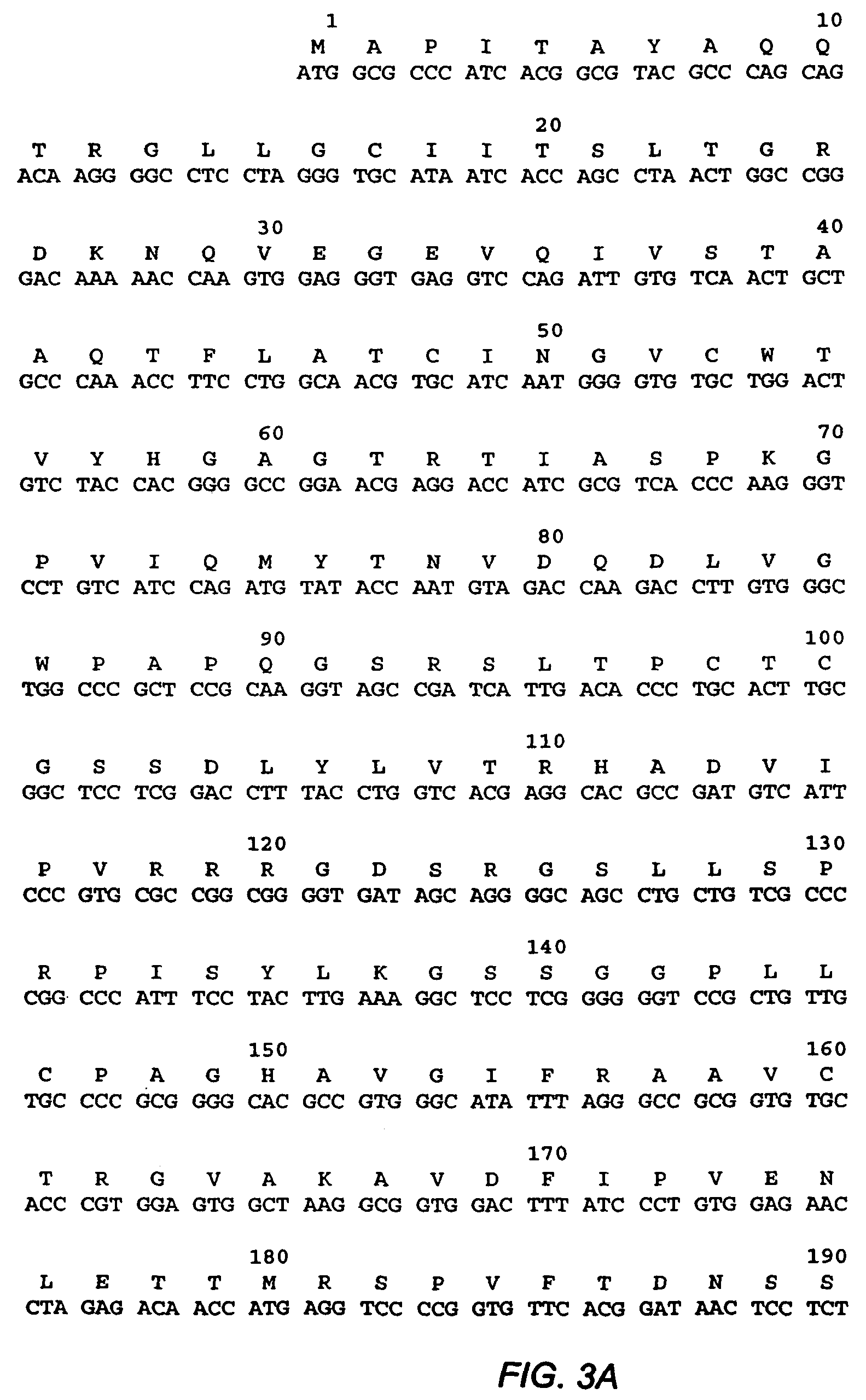HCV assay
a technology of antigen sandwich and virus, which is applied in the field of viral diagnostics, can solve the problems of a large risk for blood transfusion recipients, a significant gap between infection and virus detection, etc., and achieve the effects of improving sensitivity, reducing masking problems, and detecting antibodies
- Summary
- Abstract
- Description
- Claims
- Application Information
AI Technical Summary
Benefits of technology
Problems solved by technology
Method used
Image
Examples
example 1
Production of an NS3 / 4a Conformational Epitope with Thr to Pro and Ser to Ile Substitutions
[0146]A conformational epitope of NS3 / 4a was obtained as follows. This epitope has the sequence specified in FIGS. 3A through 3D (SEQ ID NOS:1 and 2) and differs from the native sequence at positions 403 (amino acid 1428 of the HCV-1 full-length sequence) and 404 (amino acid 1429 of the HCV-1 full-length sequence). Specifically, the Thr normally occurring at position 1428 of the native sequence has been mutated to Pro and Ser which occurs at position 1429 of the native sequence has been mutated to Ile.
[0147]In particular, the yeast expression vector used was pBS24.1. This yeast expression vector contains 2μ sequences and inverted repeats (IR) for autonomous replication in yeast, the α-factor terminator to ensure transcription termination, and the yeast leu2-d and URA3 for selection. The ColE1 origin of replication and the β-lactamase gene are also present for propagation and selection in E. co...
example 2
Purification of NS3 / 4a Conformational Epitope
[0153]The NS3 / 4a conformational epitope was purified as follows. S. cerevisiae cells from above, expressing the NS3 / 4a epitope were harvested as described above. The cells were suspended in lysis buffer (50 mM Tris pH 8.0, 150 mM NaCl, 1 mM EDTA, 1 mM PMSF, 0.1 μM pepstatin, 1 μM leupeptin) and lysed in a Dyno-Mill (Wab Willy A. Bachofon, Basel, Switzerland) or equivalent apparatus using glass beads, at a ratio of 1:1:1 cells:buffer:0.5 mm glass beads. The lysate was centrifuged at 30100×g for 30 min at 4° C. and the pellet containing the insoluble protein fraction was added to wash buffer (6 ml / g start cell pellet weight) and rocked at room temperature for 15 min. The wash buffer consisted of 50 mM NaPO4 pH 8.0, 0.3 M NaCl, 5 mM β-mercaptoethanol, 10% glycerol, 0.05% octyl glucoside, 1 mM EDTA, 1 mM PMSF, 0.1 μM pepstatin, 1 μM leupeptin. Cell debris was removed by centrifugation at 30100×g for 30 min at 4° C. The supernatant was discard...
example 3
Immunoreactivity of NS3 / 4a Conformational Epitope Verus Denatured NS3 / 4a
[0159]The immunoreactivity of the NS3 / 4a conformational epitope, produced as described above, was compared to NS3 / 4a which had been denatured by adding SDS to the NS3 / 4a conformational epitope preparation to a final concentration of 2%. The denatured NS3 / 4a and conformational NS3 / 4a were coated onto microtiter plates as described above. The c200 antigen (Hepatology (1992) 15:19–25, available in the ORTHO HCV Version 3.0 ELISA Test System, Ortho-Clinical Diagnostics, Raritan, N.J.) was also coated onto microtiter plates. The c200 antigen was used as a comparison it is presumed to be non-conformational due to the presence of reducing agent (DTT) and detergent (SDS) in its formulation.
[0160]The immunoreactivity was tested against two early HCV seroconversion panels, PHV 904 and PHV 914 (commercially available human blood samples from Boston Biomedica, Inc., West Bridgewater, Mass.). The results are shown in Table 6...
PUM
| Property | Measurement | Unit |
|---|---|---|
| temperature | aaaaa | aaaaa |
| pH | aaaaa | aaaaa |
| pH | aaaaa | aaaaa |
Abstract
Description
Claims
Application Information
 Login to View More
Login to View More - R&D
- Intellectual Property
- Life Sciences
- Materials
- Tech Scout
- Unparalleled Data Quality
- Higher Quality Content
- 60% Fewer Hallucinations
Browse by: Latest US Patents, China's latest patents, Technical Efficacy Thesaurus, Application Domain, Technology Topic, Popular Technical Reports.
© 2025 PatSnap. All rights reserved.Legal|Privacy policy|Modern Slavery Act Transparency Statement|Sitemap|About US| Contact US: help@patsnap.com



